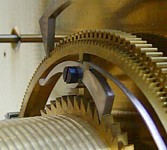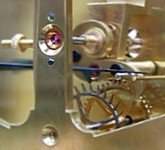





 |
 |
 |
||||
 |
 |
 |
||||
|
Munro No. 4 |
The Regulator Explained
|
|
|
 |
|
|
|
|
 |
 |
|
|
maintaining
power |
remontoire |
|
|
|
|
|
The Regulator tradition applied In this modern age, precise timekeeping is better served by other means; the inherently flawed pendulum is not adequate for scientific quality time measurement. Nevertheless, the aesthetic impact of precision horology has not lessened. The elegant fasteners, the noble curves of the levers, the visual appeal of the hand-burnished internal corners - a thousand shared details from the multiple traditions of precision horology - are the pallete from which we draw to create our artisinal creations. We start with the art of clockmaking, and from there strive to create timepieces as art. |
||
|
|
|
The
Arcadian Clock Co. (908) 276-0276
©2012 The Arcadian Clock Co.
|